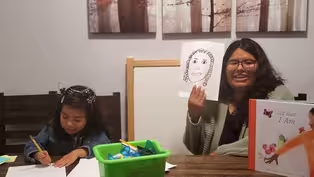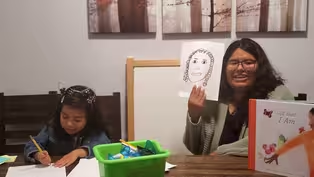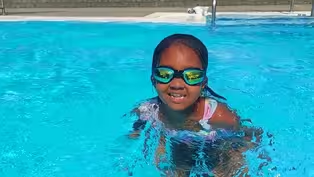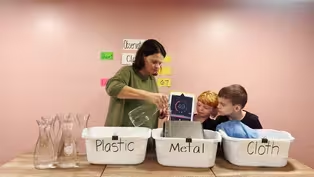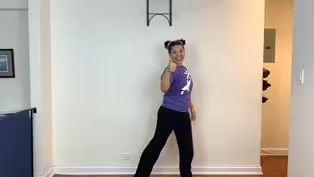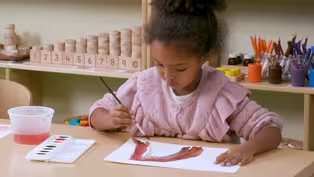
TEST THE WATER
Clip: 4/15/2023 | 6m 19sVideo has Closed Captions
Eve Townsend compares the amount of water different containers can hold.
Eve Townsend conducts an experiment to compare what happens to ice cubes in hot and cold water. Then she compares the amount of water different containers can hold.
Problems playing video? | Closed Captioning Feedback
Problems playing video? | Closed Captioning Feedback
Let's Learn is a local public television program presented by THIRTEEN PBS

TEST THE WATER
Clip: 4/15/2023 | 6m 19sVideo has Closed Captions
Eve Townsend conducts an experiment to compare what happens to ice cubes in hot and cold water. Then she compares the amount of water different containers can hold.
Problems playing video? | Closed Captioning Feedback
How to Watch Let's Learn
Let's Learn is available to stream on pbs.org and the free PBS App, available on iPhone, Apple TV, Android TV, Android smartphones, Amazon Fire TV, Amazon Fire Tablet, Roku, Samsung Smart TV, and Vizio.
Providing Support for PBS.org
Learn Moreabout PBS online sponsorship[upbeat music] Oh, hi, I've been learning so much about water and all of the different ways that we can see it.
And I'm curious to learn more.
So I've set up a little experiment.
I wanna see what will happen when I take some ice cubes and put them in cold water and put them also in hot water.
What do you think will happen?
I think both of the ice cubes will melt, but I'm not sure.
So that's why I'm gonna do the experiment.
So let me show you my materials.
I have some ice cubes here.
I also have some hot water from the sink, and I also have some cold water from the sink.
Okay, so I have all of my materials here.
How can I find out what will happen when I put an ice cube in the cold water and ice cube in the hot water?
Oh yeah.
I can test it out by putting an ice cube in the cold water and putting an ice cube in the hot water.
I have them everything right here.
I'm gonna take an ice cube.
Ooh, these are cold.
And I'm gonna drop one in the hot water and one in the cold water.
And I'm gonna watch and see what happens.
[upbeat music] Are you watching too?
What do you notice?
What do you see happening?
Hmm.
I'm looking at the cold water right now and I don't see very much happening.
The ice cube looks exactly the same.
The ice cube that's in the hot water, it's starting to look a bit smaller.
Do you see that?
What do you think?
Let's look at it a different way.
What do you notice?
It looks to me that the ice cube that's in the hot water, it's almost disappeared.
And maybe the ice cube that's in the cold water, it might be a little bit smaller.
What do you think is happening?
Did you see that?
The ice cube that was in the hot water is gone.
It completely disappeared.
It was there and now it's not.
What do you think happened?
Oh my goodness.
Do you think it melted?
That's what we've been talking about, that ice melts.
And did you see that the ice cube in the cold water got a little bit smaller too?
I think it melted a little bit too.
Wow.
So let me think about what I learned in this experiment.
I started out with hot water and cold water.
I put an ice cube into the hot water and an ice cube into the cold water.
And then I watched to see what would happen.
And I watched it for a few minutes and I saw that the ice cube that was in the hot water, it got smaller and smaller and smaller, and then it disappeared.
And the ice cube that was in the cold water, it got a little smaller and a little smaller and then it was a little smaller.
But wow, that ice cube that was in the hot water, now it's completely gone.
And there's just a little tiny bit of the ice cube left in the cold water.
That was pretty cool.
I got to see melting happen in action.
I just love experiments.
So I'm gonna do another one.
I wanna see which one of these containers holds more water.
Now this container is so much taller than this container.
I think this one is gonna hold more water.
So what I'm gonna do, I'm gonna fill this one up all the way up to the top with some water.
[upbeat music] [water glugs] [upbeat music] Now I think that if I poured all this water into here, into the shorter container, that it's gonna overflow.
So I've got this paper tile and I'm gonna put it down so I don't make a mess.
'Cause I think there's more in here.
So let's see what happens.
[water glugs] I didn't think that was gonna happen.
I need to see that again.
[water glugs] If there was more water in here.
It would've filled this all the way up to the top and overflowed, but it didn't.
Why do you think it's going on?
I don't know.
My experiment showed me that I was wrong.
Looks like this hold more water.
Wow, I had so much fun.
I'll see you next time.
Bye.
Video has Audio Description, Closed Captions
Clip: 6/12/2023 | 9m 42s | Katherine Rodriguez reads ALL THAT I AM by M.H. Clark, illustrated by Laura Carlin. (9m 42s)
Video has Closed Captions
Clip: 4/15/2023 | 9m 42s | Katherine Rodriguez reads ALL THAT I AM by M.H. Clark, illustrated by Laura Carlin. (9m 42s)
Video has Closed Captions
Clip: 4/15/2023 | 12m 12s | Anna Scretching-Cole teaches about the diagraphs th and wh. (12m 12s)
Video has Closed Captions
Clip: 4/15/2023 | 48s | Jordyn and Jada go swimming. (48s)
Video has Closed Captions
Clip: 4/15/2023 | 8m 50s | Cassondra Easterling simulates the sound rain makes on different surfaces. (8m 50s)
Video has Closed Captions
Clip: 4/15/2023 | 6m 50s | Jessi Colon from National Dance Institute performs a dance inspired by the Nile River. (6m 50s)
Video has Closed Captions
Clip: 4/15/2023 | 9m 1s | Lia Zuvilivia from Studio in a School guides students painting with watercolors. (9m 1s)
Providing Support for PBS.org
Learn Moreabout PBS online sponsorshipSupport for PBS provided by:
Let's Learn is a local public television program presented by THIRTEEN PBS
